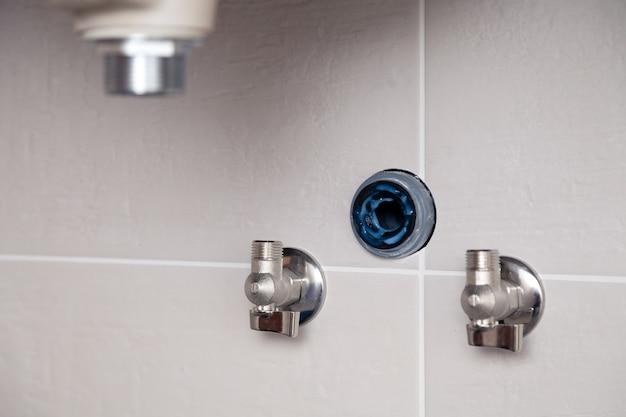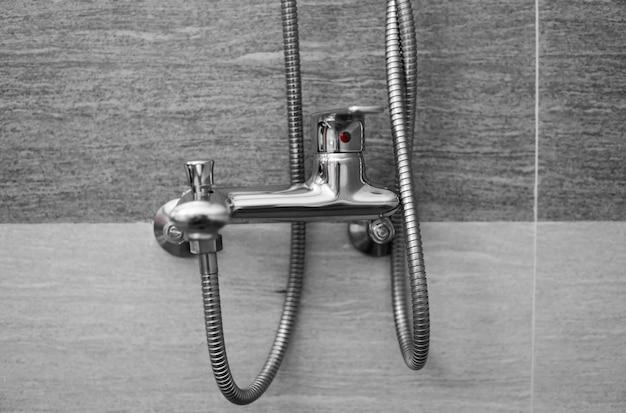Understanding the correct positioning of hot and cold water on a shower valve is essential for achieving the desired water temperature. It can be quite frustrating to step into the shower and be greeted by a blast of cold water when you were expecting a warm and soothing stream. Many people find themselves questioning which way is hot and cold on the shower valve and whether the faucet handle should be on the left or right.
In this blog post, we will explore these common concerns and provide you with the answers you’ve been looking for. We will delve into the directions to turn the hot and cold faucets, discuss the differences between hot and cold faucet cartridges, and even provide solutions for when you find yourself with an upside-down shower valve that mixes the water the wrong way. So, let’s dive in and demystify the world of shower valves and faucet handles!
What Side Is Hot And Cold On a Shower Valve
When it comes to taking a shower, one of the most essential things to figure out is which side of the shower valve controls the hot water and which side controls the cold. You wouldn’t want to accidentally scald yourself with hot water or freeze under a blast of cold water, would you? So, let’s dive in and find out which side is hot and which side is cold on a shower valve.
Understanding the Shower Valve
Before we unveil the secret to deciphering the hot and cold sides of a shower valve, let’s understand what a shower valve actually is. The shower valve is the mechanism that controls the flow and temperature of water in your shower. It usually has two handles, one for hot water and one for cold water. Some modern shower valves may have a single lever or a digital interface, but the concept remains the same.
The Red and Blue Conundrum
Now, here’s where it gets interesting. Have you ever noticed that many shower valves have red and blue markings or indicators near the handles? Well, those markings are not just there to add a pop of color to your bathroom; they actually serve a purpose. The red usually denotes hot water, while the blue represents cold water. It’s a visual cue to help you identify the temperature control.
Left is Hot, Right is Cold
So, you might be wondering, do the red and blue indicators on the shower valve correspond to the left and right handles respectively? Well, not always. While it’s common for the hot water control to be on the left and the cold water control to be on the right, it’s not a universal rule. Shower valve configurations can vary, depending on the manufacturer or the plumber who installed it.
Don’t Make Assumptions, Test it Out
To avoid any surprises, it’s best not to make assumptions about which side is hot and which side is cold on your shower valve. Instead, take a moment to experiment. Turn on the left handle and feel the water. If it’s hot, then you’ve found your answer – the left side controls the hot water. If it’s cold, well, you guessed it – the left side controls the cold water. Repeat the process with the right handle to confirm your findings.
Final Thoughts
There you have it! Figuring out the hot and cold sides of a shower valve isn’t rocket science, but it’s important to do a quick test to avoid any unexpected temperature mishaps. Remember, the red and blue markings can be helpful indicators, but they are not foolproof. Always trust your own judgment and give the handles a little twist to ensure you get the perfect temperature every time you step into the shower. Happy showering!
Note: This information is accurate as of 2023 and may vary depending on the specific shower valve in your bathroom.
FAQ: What Side is Hot and Cold on a Shower Valve
If you’ve ever stood in front of a shower valve, wondering which way is hot and which way is cold, don’t worry, you’re not alone. The confusion is real. That’s why we’ve put together this comprehensive FAQ to help you navigate the hot and cold waters of shower valve handles.
What Way is Hot and Cold
When it comes to figuring out which way is hot and which way is cold on a shower valve, the general rule of thumb is to associate left with hot and right with cold. So, if you’re looking to turn up the heat, turn the handle to the left. And if you prefer a refreshing blast of cold water, turn it to the right. Easy peasy, right?
Should the Faucet Handle be on the Left or Right
Now that you know where the hot and cold sides are, you might be wondering whether the faucet handle should be on the left or right. Well, the answer is that it really depends on personal preference and the specific shower setup. In most American households, the faucet handle is typically on the left side. However, there is no hard and fast rule, so you can go with whatever feels right for you.
Is Clockwise On or Off
Ah, the eternal question of which way to turn the handle to turn off the water. Clockwise or counterclockwise? Well, to shut off the flow, you need to turn the handle clockwise. Think of it as screwing the water off, just like you would with a screw. And to turn it back on, simply turn the handle in the opposite direction.
Is Hot Forward or Back
When it comes to hot and cold, forward and back might seem a bit ambiguous. But fear not, we’ve got you covered. In the context of a shower valve, think of forward as hotter and back as colder. So, if you’re looking to crank up the temperature, move the handle forward. And if you want to chill out, pull it back.
Which Way Should Hot and Cold Faucets Turn
To keep things consistent, hot and cold faucets generally follow the same rules as shower valves. So, for hot water, turn the faucet handle to the left, and for cold water, turn it to the right. This applies to both single-handle faucets and two-handle faucets.
Are Hot and Cold Faucet Cartridges Different
No, hot and cold faucet cartridges are typically the same. The difference lies in the manner they are installed. The hot cartridge is installed on the left side, while the cold cartridge goes on the right side. This ensures that when you turn the handle to the left, hot water is delivered, and when you turn it to the right, cold water flows.
How Do You Reverse Faucet Handles
If your faucet handles are installed in the wrong direction, causing confusion every time you shower or wash your hands, you can easily reverse them. Here’s a step-by-step guide:
- Turn off the water supply to the faucet.
- Remove the handle by unscrewing the set screw or removing the decorative cap and unscrewing it.
- Take note of the position of the handle, as you’ll need to reverse it later.
- Unscrew the escutcheon plate and remove it.
- Locate the cartridge and remove it.
- Flip the cartridge 180 degrees.
- Reinstall the cartridge, escutcheon plate, and handle in the reverse order.
- Turn on the water supply and test the new handle orientation.
Voila! Your faucet handles are now correctly aligned with the hot and cold sides.
Should Hot Water be Up or Down
In most shower setups, hot water is typically associated with the upward direction, while cold water is associated with the downward direction. So, to increase the temperature, turn the handle up, and to decrease it, turn it down. Just remember that this convention can vary depending on the manufacturer, so check your specific shower valve for any deviations.
What Happens When You Install a Shower Valve Upside Down
Installing a shower valve upside down can lead to some rather unexpected and unpleasant consequences. First and foremost, you’ll experience a complete reversal of hot and cold water. So, what was once a luxurious warm shower might become an icy blast, and vice versa. Additionally, the handle orientation will be completely off, causing confusion for anyone using the shower. So, to avoid such mishaps, be sure to install your shower valve with the hot and cold sides correctly positioned.
Which Side is Hot and Cold on Moen Shower Valve
Moen shower valves follow the same convention as most other shower valves. The left side is the hot side, while the right side is the cold side. So, if you have a Moen shower valve, remember to turn the handle to the left for hot water and to the right for cold water. With Moen, you can count on a consistent and reliable shower experience.
Which Way Do You Turn a Faucet Off
To turn off a faucet, regardless of whether it’s a shower faucet or a regular sink faucet, turn the handle clockwise. Remember, when it comes to shutting off the water flow, think “righty tighty.” And when you’re ready to turn it back on, just give it a counterclockwise twist.
Why is My Shower Mixer Not Mixing
If your shower mixer isn’t mixing the hot and cold water properly, the most likely culprit is a faulty cartridge. Over time, cartridges can become worn or clogged with mineral deposits, leading to an imbalance in temperature. To fix this issue, you’ll need to replace the cartridge with a new one. This should restore the proper mixing action and provide you with the perfect blend of hot and cold water.
Why Does My Faucet Handle Turn All the Way Around
If your faucet handle is spinning around without controlling the water flow, it’s a sign that the handle mechanism is loose or broken. The handle is likely not engaging with the valve stem, causing it to spin freely. To fix this, you’ll need to remove the handle and inspect the inner mechanism. Tightening any loose parts or replacing any broken components should restore the handle’s functionality.
Why is the Hot and Cold Water Backwards in the Shower
If you’re experiencing a rather perplexing situation where hot water feels cold and cold water feels hot, chances are your shower valve was installed incorrectly. The hot and cold water supply pipes might have been reversed during installation, causing this counterintuitive swap. To rectify this issue, you’ll need to shut off the water supply, remove the shower valve, and reinstall it with the proper orientation. It’s a bit of a hassle, but once everything is back in order, you’ll be able to enjoy the correct temperature settings in your shower once again.
Now that you’re armed with all this knowledge about shower valve handles, you can confidently step into your shower and conquer the hot and cold dilemma like a plumbing pro. So go ahead, turn that dial, and embrace the soothing cascades of water that await you. Happy showering!
Note: This blog post is for informational purposes only and should not be considered professional plumbing advice. If you encounter any serious issues with your shower valve or plumbing system, it’s always best to consult a licensed plumber.

